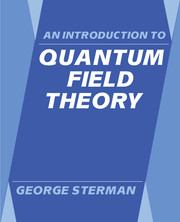Book contents
- Frontmatter
- Contents
- Preface
- PART I SCALAR FIELDS
- 1 Classical fields and symmetries
- 2 Canonical quantization
- 3 Path integrals, perturbation theory and Feynman rules
- 4 Scattering and cross sections for scalar fields
- PART II FIELDS WITH SPIN
- PART III RENORMALIZATION
- PART IV THE NATURE OF PERTURBATIVE CROSS SECTIONS
- APPENDICES
- References
- Index
3 - Path integrals, perturbation theory and Feynman rules
Published online by Cambridge University Press: 05 August 2012
- Frontmatter
- Contents
- Preface
- PART I SCALAR FIELDS
- 1 Classical fields and symmetries
- 2 Canonical quantization
- 3 Path integrals, perturbation theory and Feynman rules
- 4 Scattering and cross sections for scalar fields
- PART II FIELDS WITH SPIN
- PART III RENORMALIZATION
- PART IV THE NATURE OF PERTURBATIVE CROSS SECTIONS
- APPENDICES
- References
- Index
Summary
There is a natural solution to an interacting-field theory whenever its Lagrangian is the sum of a free (quadratic) Lagrangian and interaction terms. We associate with each interaction a multiplicative factor gi, the coupling constant for that term. We then expand S-matrix elements of the interacting-field theory around those of the free-field theory, as a power series in the gi. In this approach, the interaction is conceived as a small perturbation on the free theory; the systematic method for expanding in the coupling constant(s) is perturbation theory.
The development of field-theoretic perturbation theory can be carried out in a number of ways. We shall use the path integral method, initiated by Feynman (1949). The other commonly discussed approach, based on the interaction picture, is sketched in Appendix A.
The Feynman path integral is a reformulation of quantum mechanics in terms of classical quantities. Extensive discussions of the path integral in quantum mechanics may be found, for instance, in Feynman & Hibbs (r1965) and Schulman (r1981). Technical reviews include Keller & McLaughlin (r1975) and Marinov (r1980). For issues of mathematical rigor, which by and large are avoided below, see Glimm & Jaffe (r1981) and DeWitt-Morette, Maheshwari & Nelson (r1979).
The path integral
We first consider a quantum mechanical system with only one coordinate q and time-independent Hamiltonian H(p, q).
- Type
- Chapter
- Information
- An Introduction to Quantum Field Theory , pp. 58 - 93Publisher: Cambridge University PressPrint publication year: 1993



